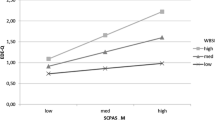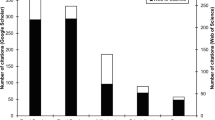Abstract
Purpose
The current study aimed to analyze individual differences on food cravings, intrusive-related thoughts and its suppression between normal weight and overweight/obese Cuban adults.
Methods
Participants were 1,184 individuals from general population, aged between 18 and 64 years (M = 32.89; SD = 12.87), with 69.1 % females. All participants answered a set of questionnaires and provided demographic, anthropometric and clinical data.
Results
Overweight/obese individuals had higher mean scores than normal weight individuals on food cravings (including its nine dimensions) and food and body weight/shape thought suppression. Large effect sizes were found for body weight/shape thoughts suppression and lack of control over eating, where overweight and obese individuals showed the highest scores. This trend was also found for food thoughts suppression, food cravings trait, cue-dependent eating, preoccupation with food and guilty feelings, with effect sizes from medium to large. Finally, medium effect sizes were observed for intention to eat and negative affect.
Conclusion
Overweight/obese individuals experienced more food cravings and food and body weight/shape thought suppression than normal weight individuals among Cuban adults.
Similar content being viewed by others
Notes
Extreme economic difficulties experienced in Cuba between 1990 and 1995 which conditioned a decrease of food (among other supplies) availability for the majority of the population.
References
Davis C (2013) From passive overeating to “Food Addiction”: a spectrum of compulsion and severity. ISRN Obesity (Article ID 435027). doi:10.1155/2013/435027
WHO Obesidad y sobrepeso (2011) Nota descriptiva, 311. http://www.who.int/mediacentre/factsheets/fs311/en/. Accessed Aug 2014
Hagobian TA, Phelan S (2013) Lifestyle interventions to reduce obesity and diabetes. Am J Lifestyle Med 7(2):84–98. doi:10.1177/1559827612449600
Quinn JM et al (2010) Can’t control yourself? Monitor those bad habits. Pers Soc Psychol Bull 36(4):499–511. doi:10.1177/0146167209360665
Davis C et al (2011) Evidence that ‘food addiction’ is a valid phenotype of obesity. Appetite 57:711–717. doi:10.1016/j.appet.2011.08.017
Davis C (2013) Compulsive overeating as an addictive behavior: overlap between food addiction and binge eating disorder. Curr Obes Rep 2:171–178. doi:10.1007/s13679-013-0049-8
Witt AA et al (2014) Do hunger and exposure to food affect scores on a measure of hedonic hunger? An experimental study. Appetite 74:1–5. doi:10.1016/j.appet.2013.11.010
Meule A et al (2012) Food cravings discriminate differentially between successful and unsuccessful dieters and non-dieters. Validation of the Food Cravings Questionnaires in German. Appetite 58:88–97. doi:10.1016/j.appet.2011.09.010
Meule A, Hermann T, Kübler A (2014) A short version of the Food Cravings Questionnaire-Trait: the FCQ-T-reduced. Front Psychol 5:190. doi:10.3389/fpsyg.2014.00190
Rodríguez-Martín BC, Molerio-Pérez O (2014) Exploring the factor structure of the Food Cravings Questionnaire-Trait in Cuban adults. Front Psychol 5:214. doi:10.3389/fpsyg.2014.00214
Kemps E, Tiggemann M (2010) A cognitive experimental approach to understanding and reducing food cravings. Curr Dir Psychol Sci 19(2):86–90. doi:10.1177/0963721410364494
Fabbricatore M et al (2011) Binge eating and BIS/BAS activity in obese patients with intense food cravings who attend weight control programs. Obes Metab 7:e21–e27
Fabbricatore M et al (2011) Food cravings and personality dimensions in overweight and obese patients attending low energy diet therapy. Obes Metab 7:e28–e34
Cepeda-Benito A et al (2000) The development and validation of Spanish versions of the state and trait food cravings questionnaires. Behav Res Ther 38:1125–1138
Meule A, Westenhöfer J, Kübler A (2011) Food cravings mediate the relationship between rigid, but not flexible control of eating behavior and dieting success. Appetite 57:582–584. doi:10.1016/j.appet.2011.07.013
Fabbricatore M et al (2012) Food craving is associated with multiple weight loss attempts. Mediterran J Nutr Metab 6(1):79–83. doi:10.1007/s12349-012-0115-x
Massey A, Hill AJ (2012) Dieting and food craving. A descriptive, quasi-prospective study. Appetite 58:781–785. doi:10.1016/j.appet.2012.01.020
Meule A et al (2013) Impulsive reactions to food-cues predict subsequent food craving. Eat Behav 15(1):99–105. doi:10.1016/j.eatbeh.2013.10.023
Meule A, Kübler A (2014) Double trouble. Trait food craving and impulsivity interactively predict food-cue affected behavioral inhibition. Appetite. doi:10.1016/j.appet.2014.04.014
Kavanagh DJ, Andrade J, May J (2005) Imaginary relish and exquisite torture: the elaborated intrusion theory of desire. Psychol Rev 112(2):446–467. doi:10.1037/0033-295X.112.2.446
May J et al (2012) Elaborated intrusion theory: a cognitive-emotional theory of food craving. Curr Obes Rep 1(2):114–121. doi:10.1007/s13679-012-0010-2
Erskine JAK (2008) Resistance can be futile: investigating behavioral rebound. Appetite 50:415–421. doi:10.1016/j.appet.2007.09.006
Erskine JAK, Georgiou GJ (2010) Effects of thought suppression on eating behaviour in restrained and non-restrained eaters. Appetite 54:499–503. doi:10.1016/j.appet.2010.02.001
Adriaanse MA et al (2011) Planning what not to eat: ironic effects of implementation intentions negating unhealthy habits. Pers Soc Psychol Bull 37(1):69–81. doi:10.1177/0146167210390523
Barnes RD, Tantleff-Dunn S (2010) Food for thought: examining the relationship between food thought suppression and weight-related outcomes. Eat Behav 11:175–179. doi:10.1016/j.eatbeh.2010.03.001
Berry LM et al (2010) Emotional and behavioural reaction to intrusive thoughts. Assessment 17(1):126–137. doi:10.1177/1073191109344694
Luciano JV et al (2006) Confirmatory factor analysis of the White Bear Suppression Inventory and the Thought Control Questionnaire. Eur J Psychol Assess 22(4):250–258. doi:10.1027/1015-5759.22.4.250
Luciano JV et al (2005) Development and validation of the Thought Control Ability Questionnaire. Personal Individ Differ 38:997–1008. doi:10.1016/j.paid.2004.06.020
Peterson RD (2008) Food for thought: the relationship between thought suppression and weight control in department of psychology. University of Central Florida, Orlando
Elsner RJF (2003) Changes in eating behavior during the aging process. Eat Behav 3:15–43
MINSAP (2011) Programa del médico y enfermera de la familia.Ciudad de La Habana: eciMed
Rodríguez-Martín BC, Molerio-Pérez O (eds) (2012) Validación de Instrumentos Psicológicos. Feijóo, Santa Clara
Rodríguez-Martín BC et al (2012) Cuestionario del Ciclo del Peso. In: Rodríguez-Martín BC, Molerio-Pérez O (eds) Validación de Instrumentos Psicológicos: Criterios Básicos. Feijóo, Santa Clara, p 58–64
Wegner DM, Zanakos S (1994) Chronic thought suppression. J Pers Soc Psychol 6(4):615–640
Barnes RD, Fisak BJR, Tantleff-Dunn S (2009) Validation of the Food Thought Suppression Inventory. J Health Psychol 15(3):373–381. doi:10.1177/1359105309351246
Barnes RD, White MA (2010) Psychometric properties of the Food Thought Suppression Inventory in men. J Health Psychol 15(7):1113–1120. doi:10.1177/1359105310365179
Rodríguez-Martín BC et al (2012) Inventarios de Supresión de Pensamientos. In: Validación de Instrumentos Psicológicos: Criterios Básicos, Feijóo, Santa Clara, p. 25–35
Rodríguez-Martín BC et al (2012) Cuestionario de Reacciones Emocionales y Conductuales a los Pensamientos Intrusos. In: Rodríguez-Martín BC, Molerio-Pérez O (eds) Validación de Instrumentos Psicológicos: Criterios Básicos. Feijóo, Santa Clara, p 50–57
Rodríguez-Martín BC et al (2012) Cuestionario Reducido de Control de Pensamientos. In: Rodríguez-Martín BC, Molerio-Pérez O (eds) Validación de Instrumentos Psicológicos: Criterios Básicos. Feijóo, Santa Clara, p 36–43
Rodríguez-Martín BC et al (2012) Cuestionario Habilidad para el Control de Pensamientos (versión abreviada). In: Rodríguez-Martín BC, Molerio-Pérez O (eds) Validación de Instrumentos Psicológicos: Criterios Básicos, Feijóo, Santa Clara, p 44–50
Ledesma RD, Macbeth G, Cortada de Cohan N (2009) Computing effect size measures with ViSta: the Visual Statistics System. Tutor Quant Methods Psychol 5(1):25–34
Rice MJ (2009) Effect size in psychiatric evidence-based practice care. J Am Psychiatr Nurses Assoc 15:138–142. doi:10.1177/1078390309335007
Hall M et al (2009) The WEKA Data Mining Software: an update. SIGKDD Explor 11(1):10–18
Novaković J, Strbac P, Bulatović D (2011) Toward optimal feature selection using ranking methods and classification algorithms. Yugoslav J Oper Res 21:119–135. doi:10.2298/YJOR1101119N
Míguel-Bernárdez M et al (2011) Concordancia entre la autopercepción de la imagen corporal y el estado nutricional en universitarios de Orense. Nutrición Hospitalaria 26(3):472–479. doi:10.3305/nh.2011.26.3.4604
Guzmán R, Lugli Z (2009) Obesidad y satisfacción con la vida: un análisis de trayectoria. Suma Psicológica 16(2):37–50
Quick vm, Byrd-Bredbenner C (2012) Weight regulation practices of young adults. Predictors of restrictive eating. Appetite 59:425–430. doi:10.1016/j.appet.2012.06.004
Musiat P et al (2014) Association splitting: feasibility study of a novel technique to reduce weight and shape concerns. Eat Weight Disord 19:153–158. doi:10.1007/s40519-014-0109-4
Houben K, Nederkoorn C, Jansen A (2012) Too tempting to resist? Past success at weight control rather than dietary restraint determines exposure-induced disinhibited eating. Appetite 59:500–505. doi:10.1016/j.appet.2012.07.004
Innamorati M et al (2014) Food Cravings Questionnaire-Trait (FCQ–T) discriminates between obese and overweight patients with and without binge eating tendencies: the Italian Version of the FCQ–T. J Personal Assess. doi:10.1080/00223891.2014.909449
Vander-Wal JS, Johnston KA, Dhurandhar NV (2007) Psychometric properties of the State and Trait Food Cravings Questionnaires among overweight and obese persons. Eat Behav 8:211–223. doi:10.1016/j.eatbeh.2006.06.002
Barnes RD, Masheb RM, Grilo CM (2011) Food thought suppression: a matched comparison of obese individuals with and without binge eating disorder. Eat Behav 12:272–276. doi:10.1016/j.eatbeh.2011.07.011
Meule A et al (2012) High-calorie food-cues impair working memory performance in high and low food cravers. Appetite 59:264–269. doi:10.1016/j.appet.2012.05.010
Macht M (2008) How emotions affect eating: a five-way model. Appetite 50:1–11. doi:10.1016/j.appet.2007.07.002
Adriaanse MA, de Ridder DTD, de Wit JBF (2009) Finding the critical cue: implementation intentions to change one’s diet work best when tailored to personally relevant reasons for unhealthy eating. Pers Soc Psychol Bull 35(1):60–71. doi:10.1177/0146167208325612
Lagerros YT, Rössner S (2013) Obesity management: what brings success? Ther Adv Gastroenterol 6(1):77–88. doi:10.1177/1756283X12459413
Kupusinac A, Stokić E, Doroslovački R (2014) Predicting body fat percentage based on gender, age and BMI by using artificial neural networks. Comput Methods Progr Biomed 113:310–319. doi:10.1016/j.cmpb.2013.10.013
Singh DK, Tuli L (2010) Obesity and its mechanisms—who to blame after marriage? Med Hypotheses 75:472–473. doi:10.1016/j.mehy.2010.04.022
Bove CF, Sobal J (2011) Body weight relationships in early marriage. Weight relevance, weight comparisons, and weight talk. Appetite 57:729–742. doi:10.1016/j.appet.2011.08.007
Lowe MR et al (2013) Dieting and restrained eating as prospective predictors of weight gain. Front Psychol 4:577. doi:10.3389/fpsyg.2013.00577
Giuliani NR, Calcott RD, Berkman ET (2013) Piece of cake: cognitive reappraisal of food craving. Appetite 64:56–61. doi:10.1016/j.appet.2012.12.020
Soetens B, Braet C, Moens E (2008) Thought suppression in obese and non-obese restrained eaters: piece of cake or forbidden fruit? Eur Eat Disord Rev 16:67–76. doi:10.1002/erv.771
Svaldi J et al (2012) The effects of emotion regulation on the desire to overeat in restrained eaters. Appetite 59:256–263. doi:10.1016/j.appet.2012.04.016
Wadlimger HA, Isaacowitz DM (2010) Fixing our focus: training attention to regulate emotion. Personal Soc Psychol Rev 2(10):1–28. doi:10.1177/1088868310365565
Conflict of interest
None.
Author information
Authors and Affiliations
Corresponding author
Rights and permissions
About this article
Cite this article
Rodríguez-Martín, B.C., Gil-Pérez, P. & Pérez-Morales, I. Exploring the “weight” of food cravings and thought suppression among Cuban adults. Eat Weight Disord 20, 249–256 (2015). https://doi.org/10.1007/s40519-014-0163-y
Received:
Accepted:
Published:
Issue Date:
DOI: https://doi.org/10.1007/s40519-014-0163-y




